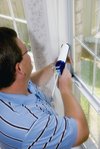

With summer just around the corner, it is important to prepare for the increasing temperatures, especially if a heatwave like the one Clark County experienced last year happens again.
Dameon Pesanti, a media specialist at Clark Public Utilities, has some tips on how to do a weather tune-up to keep one’s home cooler, while saving money on energy use.
“The good thing is it would probably take you an afternoon or two to do this stuff, and it will pay off to help your home stay comfortable and save you a bit of energy throughout the hottest part of the year,” Pesanti said. “Most of the materials people will need to do these kinds of projects are widely available from any hardware store or home improvement retailer. You don’t need to be a pro to do (a warm weather tune-up) either.”
One of the first things Pesanti suggests is to go outside and circle around the perimeter of the home to inspect the caulking, which seals doors, window frames, and siding on certain homes.
“That stuff doesn’t last forever, so if it’s peeling or cracked, if it’s separating off the wall, or if it’s missing, the best thing to do is to just scrape it off, clean that surface, and replace that caulk,” he explained.
Pesanti said caulk is cheap, easy to apply, and can last for years. He said it should make a difference because it will “seal the envelope of your home and keep that unconditioned air out but keep the conditioned air in, which is what you want because the longer you’re able to hold that conditioned air in your house, the less energy you have to use to condition it again.”
He also said people should think of their homes like a cooler, which traps cool air inside. If left open, even just a little bit, the cool air will leak out and hot air will come in, melting what is stored inside.
“Those leaks that you should be caulking shut will never stop. It’s going to leak air 24/7,” Pesanti said. “One or two of them by themselves might not be a big deal, but if your caulk is in poor condition throughout your house, all of those little gaps are going to add up to a lot of leakage. That’s going to affect your energy bill and also your comfort because the house isn’t going to stay at those cool temperatures as long as it could if your house was sealed up well.”
When people start using their air conditioner, Pesanti said a well-sealed home will keep the cool air in longer without having to keep the machine on all day. Old caulk must be scraped out entirely, rather than just filling a small gap.
“You really want to replace the old stuff all the way because if it is cracking a little bit, it’s only going to crack more,” he said.
Another method to weather-tune a home is to look at the weather stripping and the threshold around exterior doors, which also sometimes doesn’t last long since it “constantly takes abuse” when doors are opened and closed.
“If it’s not in good shape, if you spot any gaps, or if it’s even coming apart a little bit, rip that stuff out and replace it,” Pesanti said.
Like caulk, he said bad weather stripping will lead to air leaks and could result in energy waste. For people with pets, he said it’s also a good idea to make sure the animals don’t tear at the weather stripping since they can easily damage it. Pesanti said the shelf life of weather stripping varies depending on the material it is made out of.
Pesanti considers even the best windows “very poor insulators.” While people are not able to make many adjustments to the windows themselves, they can invest in blinds or drapes.
“With a good pair of blinds or drapes, they’ll be able to block the afternoon sun from coming into their house and cut off the greenhouse effect that happens. It’ll also prevent the sunlight from coming into their house when they don’t want it to be warm,” he said.
Besides the obvious openings in a house, Pesanti said air can leak through the ceilings, so people should inspect for gaps between the light fixtures and the sheetrock. Caulk can then be used to seal those gaps shut. Electrical outlets are no exception. That problem can be solved with packs of foam plates that go between the wall and outlet faceplate.
“All you do is unscrew the faceplate, put that little foam piece in, and screw it back on, and those will help seal those gaps and hold that conditioned air in,” he said, noting the foam packs aren’t expensive.
For more tips, people can reach Clark Public Utilities at 360-992-3000.